Property Prices in Malta
These documents contain excerpts about property prices in Malta, mdina and valletta obtained from the Central Bank Annual Reports issued between 1998 and 2009. Excerpts taken from the Central Bank Annual Reports:
http://www.centralbankmalta.com/site/publications2.asp
To view a particular document click on one of the 'View Report' links below. You are also
able to download the respective documents by right-clicking on one of the 'Download Report' links and selecting 'Save Target As...'
View Report: [2009] [2008] [2007] [2006] [2005] [2004 - 2001] [2000 - 1998]
Download Report: [2009] [2008] [2007] [2006] [2005] [2004 - 2001] [2000 - 1998]
2005 Report
Introduction
Malta is one of the most densely populated areas
in the world.1 This makes land in Malta a relatively
expensive asset, with houses comprising one of
the major vehicles of investment in which a large
proportion of domestic equity is traditionally
kept.
Developments in the housing market have
important implications for existing homeowners,
real estate agents and operators in the
construction industry. Demand and supply
conditions as well as movements in house prices
are also of concern to the Central Bank of Malta in
view of the latter’s responsibility for maintaining
price and financial market stability.
A number of academic papers have commented on
asset price behaviour and, in certain cases, the
appropriate policy response. Thus, Bernanke and
Gertler (1999) explore the implications of asset
price volatility for the management of monetary
policy, and show that it is desirable for central
banks to focus on underlying inflationary pressures rather than on asset prices themselves.
In contrast, Bordo and Jeanne (2002) note that
acting pre-emptively through monetary policy
when asset prices are booming can sometimes be
beneficial given the potentially large welfare costs
in terms of output and wealth resulting from a
subsequent collapse in asset prices.
The question of why the monitoring of house
prices is important for a central bank remains an
essential issue for the setting of monetary policy.
Cecchetti et al. (2000) argue for a monetary policy
strategy that reacts pro-actively to asset prices,
especially housing prices. According to the IMF’s
World Economic Outlook (2003), house price
busts were slightly less frequent than equity price
busts in the post-war period, but were associated
with larger adverse financial and real effects.
Helbling and Terrones (2003) state that this may
imply that monetary authorities should pay
relatively more attention to housing prices than to
equity prices. Gruen et al (2003) find that, ceteris
paribus, the case for “leaning against” an assetprice
bubble through monetary policy is stronger
the lower the probability of the bubble bursting of its own accord, the larger the efficiency losses
associated with big bubbles, and the higher the
assumed impact of monetary policy on the bubble
process.
House prices are also important with respect to
the stability and soundness of the banking
system. Rising house prices generally boost the
value of collateralised property. This encourages
banks to lend further, thus expanding total
domestic credit. Borio and Lowe (2002) state that
sustained rapid credit growth, combined with large
increases in asset prices (equity prices, residential
and commercial real estate), appears to increase
the probability of an episode of financial
instability. Accordingly, in some situations a
monetary response to credit and asset market
developments may be appropriate to preserve
both financial and monetary stability.
This concern arises because falling house prices
can have serious adverse effects: bank collateral
shrinks and non-performing loans rise, severely
curtailing the capacity of banks to lend, as
occurred in Japan in the latter part of 1980s. The
collapse of house prices weakened the Japanese
financial system and increased the taxpayer’s
burden to compensate for the losses incurred by
investors (Shiratsuka, 2003). The same occurred
in some European countries, such as Finland,
where the housing market boom in the 1980s was
encouraged by excessive lending following
financial liberalisation. In Sweden, following the
collapse of a house price bubble in the early
1990s, house prices fell to their pre-boom levels
leaving banks exposed as the collateral pledged
against the mortgage was valued at less than the
loans outstanding (Royal Institution of Chartered
Surveyors, 2003).
Detken and Smets (2003) analyse 38 boom periods
since the 1970s in 18 OECD countries. During
boom periods, the authors observe real
investment hikes and loose monetary conditions.
However, they note that not all booms are followed by large output losses. They observe
that high-cost booms are those in which real estate
prices and investment crash in post-boom periods.
High-cost booms seem to follow very rapid
growth in real money and real credit stocks just
before the boom and at the early stages of the
boom. During high-cost booms, rates of change
of real estate prices and consumption growth are
significantly higher and the investment (especially
housing) GDP ratio deviation from trend rises
faster over the whole boom period.
In the local context, various initiatives have been
taken in recent years to analyse and measure
aspects of the housing market in Malta. Demarco
(1995) constructed a house price index based on
advertised house prices both by type and locality
going back to 1980. He studied the relationship
between house prices and personal income and
analysed certain factors that may have impacted
on the local housing market, such as local and
foreign demand, subsidised housing, the rent
laws, restrictions on land for development
purposes and the demand for property as an
investment.
Cordina (1999) built various supply and demand
models to analyse the change in house prices. He
considered four strategies: subsidising demand,
encouraging market supply, setting price ceilings
and the provision of Government housing.
Camilleri (2000a) constructed a housing
affordability index as a valuation model that
combines the market rates of affordable housing
and the household median income together with
the dwelling size, to arrive at an affordable home.
Brinkworth and Vella (2000) also developed a
calculation of affordability of a two and threebedroomed
flat and analyse the market
affordability of social applicants, while Delia
(2000) analyses the economic prospects for the
future of social housing in Malta.
Mifsud (2000) studied the economic impact of
housing schemes that were introduced in the 1980s. He noted that the provision of low-priced
and free building plots for housing prevented
house prices from rising beyond the normal index
of inflation. When these schemes were stopped
to channel urban development activity into
existing and planned development areas, house
prices increased much faster than the GDP.
However, according to Mifsud, this may not
have been brought about by the planning
policies themselves, since a large number of
building permits have been issued each year
since 1993.
This paper seeks to build upon previous
contributions and to analyse further the main
determinants of house prices in Malta. For this
purpose, a new house price index based on
advertised prices from 1980 to 2004 was developed
(Central Bank of Malta, 2004). In the following
sections, the paper first explores demand-side
factors, such as demographics and affordability
ratios, before analysing supply-side factors, such
as development permits granted and the existence
of vacant properties. The paper then considers
monetary aspects and studies the link between
the growth in bank lending and average house
prices. Finally, movements in house prices are
compared with those in the Malta Stock Exchange
Index (MSEI).
Factors affecting demand
According to the Census of Population 1985 and
1995, the total population in Malta stood at
345,705 and 378,404, respectively. The number of
households was 104,742 in 1985 and 127,970 in
1995. This implies an increase of 32,699 in
population and a 23,228 increase in households
during this period. Table 1 gives the official
figures for the population from 1985 to 2003, together with the estimated number of households
for the same period. The latter were estimated by: (i) taking the ratio of households to population in
1985 and 1995 and smoothing the difference in
values between these years; (ii) using the same ratio of households to
population in 1995 to estimate the number of
households for the subsequent years to 2003.
Between 1995 and 2003 the population increased
by 21,463 while the estimated number of
households increased by 7,225. The ratio of the
population increase divided by the increase in
households is 2.97, which is very close to the
official figure of an average of 3.1 persons per
household in 1995.
Table 1 also shows the number of marriages per
year. Although one can interpret these figures as
the increase in the demand for housing by firsttime
buyers in each year, the net increase in
households each year is not necessarily
equivalent to the number of marriages. The
increase in first-time buyers due to marriages is
supplemented by single people living alone,
separated couples, households seeking to buy a
second property and foreigners purchasing
property in Malta. On the other hand, the number
of existing households is also reduced each year
as people living alone die. Consequently, the
estimated change in the number of households in
Table 1 is significantly less than the number of
marriages. These patterns may result in a partially
segmented property market, with first-time buyers
being more likely to purchase flats and
maisonettes. Thus, while the demand for flats and
maisonettes is growing at least in line with the
number of marriages each year, this increase is counterbalanced by the availability of a number of
vacant properties coming into the market as a
result of the deaths of people living alone.
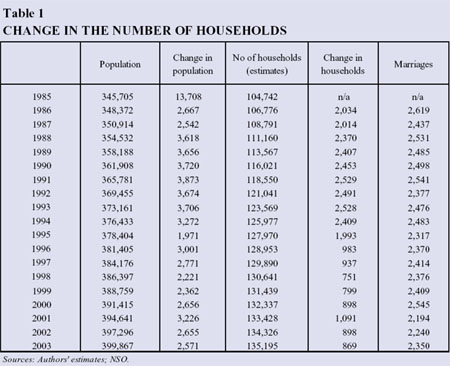
Property demand is affected in the long run by
households’ nominal income. In the short run,
however, purchasing power is provided by banks
through the provision of mortgages. Over time,
average income usually rises, allowing mortgages
to increase simultaneously. Table 2 shows the
maximum amount that could be borrowed from the
banks by a worker earning an average income. The loans for single applicants are based on the
assumption that the maximum loan is four times as
much as the gross annual salary. The loans for
joint applicants up to 1998 are based on the
assumption that the maximum loan is four times
the income of the husband plus an additional
Lm5,000. From 1999 onwards the maximum loan
available is 3.5 times the joint income. Moreover,
after 1995 banks increased the repayment period
from 25 to 30 years and after 2003 this was
increased to 40 years. Hence, this easing of
lending policies allowed banks to provide larger
mortgages for an extended number of years,
further accommodating demand.
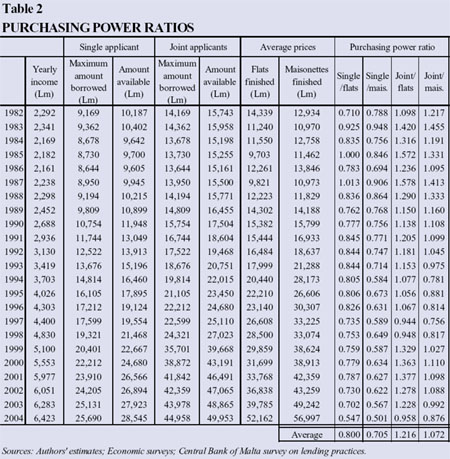
This Table also shows the amount that has to be
made available for single and joint applicants to
be able to purchase a property. It is assumed that
the loan from the bank is only 90% of the value
required, while the buyers must provide the
remaining 10%. In addition, Table 2 also shows
the purchasing power of single and joint
applicants with regard to purchasing a finished flat or maisonette. The latter are also shown in
Chart 1.
This Chart shows that throughout the survey
period a single applicant with an average income
would have been in a difficult position to afford a
flat or maisonette. It is estimated that a single
person, on average, had 80% of the funds required to purchase a flat and 71% of the funds
to purchase a maisonette. Conversely, under the
same conditions it was easier for a couple to
purchase a flat or a maisonette. As can be seen
from Table 1, a couple had, on average, 122% of
the funds required to purchase a flat and 107% of
the funds required to purchase a maisonette.
In 1997 and 1998 the purchasing power of a
couple dropped to 95% of the value of a flat and
82% of the value for maisonettes. This may have
been one factor that induced banks in 1999 to ease
their lending policies. However, the purchasing power of a couple fell after 2001 to 96% of the
value of a flat and 88% in case of a maisonette in
2004.
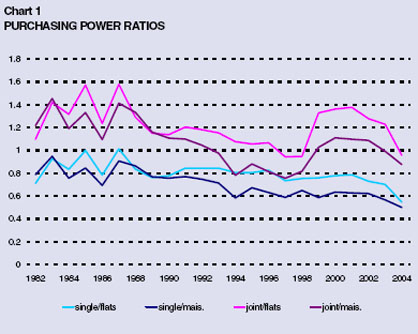
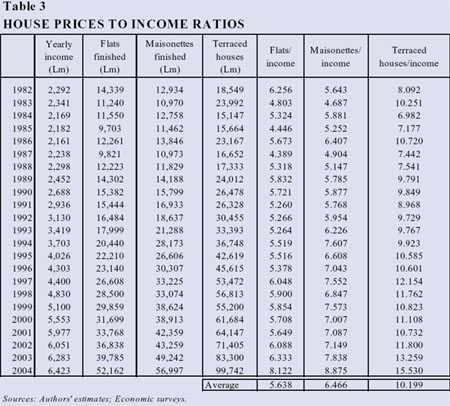
One commonly used measure of the relative
affordability of housing is the ratio of the average
house price to average disposable income
(PriceWaterhouseCoopers, 2004). Table 3 shows
such affordability ratios with respect to finished
maisonettes and flats as well as terraced houses.
The affordability ratio is simply the average value
of the property as a proportion of the average
yearly income. In 2004, the average buyer needed
8.12 years of income to purchase a flat, 8.87 years
of income to purchase a maisonette and 15.53
years for terraced houses. For the whole period
1982-2004, the affordability ratio averaged 5.64
years for flats, 6.47 years for maisonettes and
10.20 years for terraced houses. One notes that
over the last two years, the ratio has increased
significantly.
Demographic factors, mainly the increase in
households, have slowly increased the demand
for housing on a yearly basis. Furthermore, the
growth in average yearly income provided further
impetus for the banks to provide larger amounts of
credit towards house purchases.
Factors influencing supply
Table 4 shows the overall position of the housing
stock as at the 1995 Census of Population. In
every category of housing a significant proportion
of properties appears vacant. Overall, 35,723
properties (23% of total) were vacant as at census
date, a third of which were summer residences
(12,967 properties). At 40%, the highest
proportion of vacant properties was recorded in
the flats category.
The phenomenon of vacant properties also existed
in previous censuses. According to the 1957
Census, vacant properties were 6.13% of total
housing stock. In 1967 the proportion stood at
14.7% and in 1985 this rose to 19.2%. Over the
span of 38 years to 1995, the proportion of vacant
properties rose to 23.0%. Moreover, according to
the 1995 Census, 23.6% of 35,723 vacant properties
were newly constructed, 50% were in a good state
of repair, 20% were in need of repair while the rest
(6.4%) were in a dilapidated condition.
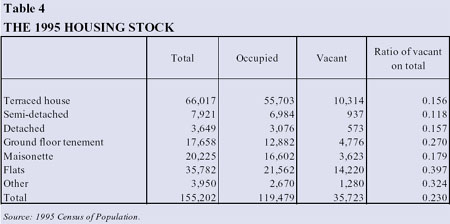
Table 5 shows the ratio of total new permits for
the construction of apartments and maisonettes
to the number of marriages each year. It is
assumed that the housing market is partially
segmented and that these types of dwellings are
mainly sold to newly-weds who are first-time
buyers. Over the eight years to 2000, 18,401
permits were granted for new apartments and
maisonettes while 19,390 marriages took place.
This amounts to a ratio of 0.95 dwellings per
couple. Hence, if we assume a segmented
housing market with newly-weds purchasing
mainly apartments and maisonettes, one can
conclude that there was a relatively stable
relationship between demand and supply in this
market during this period. However, between 2001 and 2003, 13,394 permits were granted for
apartments and maisonettes while 6,784 marriages
occurred. The ratio of dwellings to marriages
stood at 1.97. Consequently, over this period one
notes a significant excess supply of apartments
and maisonettes for first-time buyers, though this
excess may be overstated if other categories of
buyers also entered the market. Prices of
apartments and maisonettes kept on rising during
this latter period, despite the presence of an
apparently significant excess supply.
The relationship between total permits for new
dwellings and the increase in households per year
between 1993 and 2003 is shown in Table 6. Over
this period, permits for a total of 37,066 new dwellings (apartments, maisonettes and terraced
houses) were issued while the increase in
households stood at 14,154. If we accept the
above reasoning that the supply of apartments
and maisonettes is being met by the demand from
newly-weds (at least up to 2000), then 22,912
mostly already-built properties (the difference
between 37,066 new dwellings and the 14,154
increase in households) became vacant between
the years 1993 and 2003. This has pushed up
the ratio to 2.62 new dwellings for every new
household over the ten-year period. Thus, one
can conclude that up to the year 2000, the vacant
property phenomenon is what caused excess
supply in the total property market, as until then,
the number of new flats and maisonettes equalled
the number of marriages. After 2000, the vacant
properties included both previously-built
properties and newly-built apartments and
maisonettes. An increase in vacant properties normally implies a less efficient use of scarce land
resources.
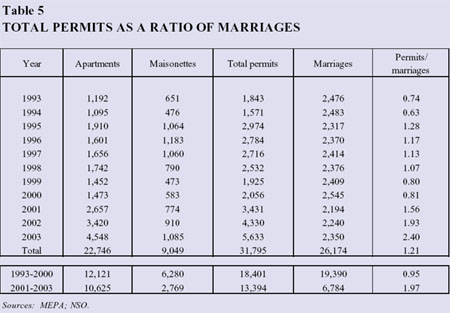
If this line of reasoning holds, one has to
consider why such a large number of properties
were still being held vacant. The current rent
legislation is probably one of the reasons for this
phenomenon. The fact that housing is also
considered as a prime investment vehicle by the
Maltese is another possible factor. Hence, the
increase in housing stock could reflect a desire to
allocate a larger share of total investment to
housing due to a perceived lack of alternative
local investment outlets. In addition, developers
may consider property to be a good investment
and so are reluctant to lower prices.
Paradoxically, vacant properties increased
simultaneously with the increase in house prices,
possibly because property owners were expecting large capital appreciation on their property and so
they were reluctant to sell at lower prices. Other
reasons could be inheritance problems within
families and the perception among the Maltese
public that property appreciates faster than other
assets.
One should also note that the 37,066 new permits
issued between 1993-2003 amount to 23.9% of the
total housing stock as at the 1995 Census. On the
basis of past trends and the analysis above, it is
likely that the Census of 2005 will reveal an even
larger proportion of vacant properties. Indeed,
Manduca (2004), quoting the Malta Environment
and Planning Authority (MEPA), reports that the
vacant housing stock increased by 4,000
properties in 2003 alone.
MEPA was established on 30 October 1992,
evolving from the Planning Area Permits Board
(PAPB) within the Works Department. To date
and under the present planning system, urban
development and environmental protection are
controlled by MEPA through the Development
Planning Act (1992) and the Environment
Protection Act (1991).
The 1988 Act allocated schemes for building
development and designated the boundaries for
future urban areas. The Structure Plan set up a
number of local plans which required the revision
of the existing building schemes based on the
Temporary Provisions Schemes (TPS) of 1988.
The Structure Plan includes two main policies: first, that no form of urban development can be
permitted outside the existing and committed builtup
areas and, second, that any permits for urban
development outside the specified boundaries
must first be approved by MEPA. These policies
probably increased the relative price of land within
the acceptable building boundaries.
Another factor influencing supply was the
strictness of the rent-related regulatory regime
existing before 1995, which was a key element
deterring owners from putting their property on
the rental market. As time went by, rent
regulations created significant market
inefficiencies, exacerbating the shortage in
available housing for rent even though many
vacant properties existed. Over time, the lack of
available property for rent induced households to
purchase property and become homeowners.
Apart from causing a shortage in supply of
housing for rent, rent regulations also led to a
deterioration of the housing stock that was rented
for minimal amounts, as it was not profitable for
landlords to invest in the upkeep of their property.
In 1995 the rent laws were amended so that
landlords could start renting to Maltese tenants
at market rates and could raise the rent on the
expiration of the lease agreement. However,
owners may still be reluctant to rent to Maltese
tenants, possibly due to fears that the current
legislation may be revised, combined with a lack
of faith in the ability of the judicial system to
enforce rent agreements efficiently.
Monetary factors
Every transaction in the real sector of the
economy is accompanied by a corresponding one
in the monetary sector. The majority of house
purchases are financed through bank mortgages.
Hence, the volume of house loans outstanding
represents the monetary side of the transactions
that occur when house purchases are made. The
monetary values of bank loans directed towards
house purchases provide the mechanism that
matches the demand with the supply side of the
market.
Chart 2 shows the total house loans outstanding
in the banking system between 1980 and the third
quarter of 2004. Total house loans include loans
towards the construction and modernisation of
existing dwellings, together with loans for the
purchase of completed dwellings. As indicated in
the Chart, total house loans have increased over
the years at a steady exponential rate, reaching
Lm512 million in the third quarter of 2004.
Chart 2 also illustrates the year-on-year
percentage change in total house loans
outstanding. Rapid growth rates are evident in the
early 1980s up to March 1986, where the average
yearly percentage change amounted to 33.5%.
Subsequently, the annual percentage change of
house loans fluctuated almost within a band of
10% to 20%. Between March 1986 and September 2004, the average percentage change amounted to
15%, while the average growth rate for the whole
period was 19.1%.
Monetary theory links movements in prices to
monetary growth, reflected to a large extent in
domestic credit expansion when there are no
distortions in the credit market. House prices, as
measured by the revised Central Bank of Malta
house price index, increased on average by 7%
per year from 1980 to 2004. The link between the
movements in house prices and bank credit is
clearly observed in the years after 1986. Thus,
while the annual increase in house prices
between 1986 and 2004 was 8.5%, there was a
15% yearly growth in bank credit for mortgages.
However, house prices between 1980 and 1986
remained stable despite significantly high growth
rates in total mortgage loans (averaging 33.5% on
an annual basis) during this period. This was due
to the fact that the Government was actively
subsidising the housing market through the sale
of plots of land at very low prices to young
couples. In addition, there was a greater tendency
towards home ownership coinciding with a new
burst of borrowing for housing at that time. Thus,
one can conclude that monetary growth is
necessary, but not sufficient to generate increases
in house prices.
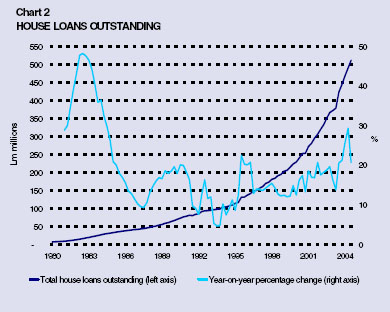
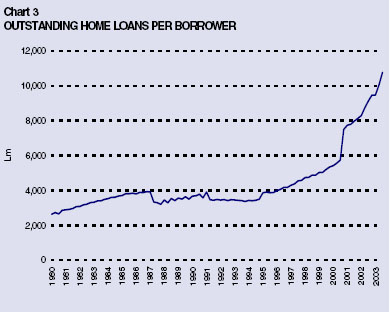
Strong expansion in mortgage lending in recent years is also shown by the growth in total house
loans per capita as depicted in Chart 3. Total
home loans outstanding per capita steadily
increased from Lm2,637 in March 1980 to Lm3,925
in December 1986, remaining below Lm4,000 up to
June 1996, and then steadily increasing to reach
Lm6,000 by December 2000. Since then, home
loans per capita continued to increase, reaching
an estimated Lm8,000 by December 2001,
Lm10,000 by June 2003 and Lm10,778 by
September 2003.
The house loans mentioned above are not the
only bank credit provided to the property sector.
Three other types of property-related facilities were
identified. These include loans towards the
building and construction sector, loans for re-sale
and development of property and loans towards
the construction, upgrading and modernisation of
hotels. The total outstanding credit to these three
sectors, together with the total mortgages for house
loans, is depicted in Chart 4. This chart shows that
total property lending reached Lm200 million by the
first quarter of 1994, before accelerating to reach
Lm900 million by September 2004.
The year-on-year percentage change in total
property lending is also depicted in Chart 4, which
shows a double-digit rise in almost all the years. Annual growth rates fluctuated for most of the
years within a band between 10% and 20%, with an average annual growth of 17%.
The rapid rates of growth in property lending
caused the proportion of total property lending to
total bank lending, which is depicted in Chart 5, to
increase. In the early 1980s property lending
accounted for 22% of total bank lending. This
ratio increased throughout the years to reach 43%
by the third quarter of 2004. Similarly, total house
mortgages accounted for 10% of total bank
lending in 1980, rising to 25% by 2004. Chart 7
clearly shows the growing importance of property
lending for banks. Over the last 25 years bank
credit related to property increased significantly
and almost doubled as a share of the total loan
portfolio. This reflects the increased importance
of the growth of the property industry in the
Maltese economy relative to other productive
sectors.
Rate of growth in house prices
The Central Bank of Malta has extended its
house prices index, which is based on advertised
prices, to include average and median prices for
different types of properties since 1980 (Central
Bank of Malta, 2004). The types of properties surveyed include flats and maisonettes in both
shell and finished form, terraced houses, town
houses, houses of character, villas and bungalows
as well as luxury properties. A price index was
developed for each of these categories as well as
for the overall average, weighted by the number
of properties in each category. See Appendix 1
for average property prices and Appendix 2 for
median prices. Work on further refinements to the
index is ongoing.
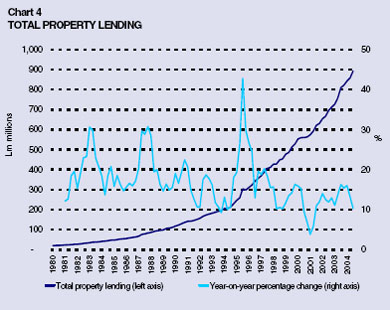
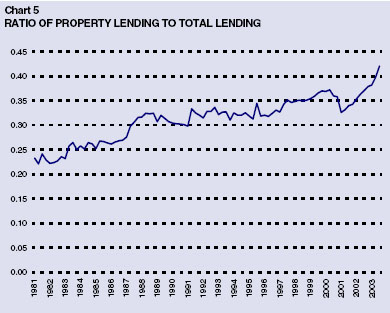
Chart 6 shows the growth in advertised median
and average prices across all types of property. A
close relationship is observed between the growth
rates in median and average prices. Prices
remained relatively stable between 1980 and 1987
and started to increase thereafter. Overall,
average prices were Lm17,009 in 1980 and
Lm16,364 in 1987, and then increased 5.3 times to
Lm86,376 by 2004. Similarly, overall median prices
were Lm16,661 in 1980 and Lm15,509 in 1987, and
had increased 5.1 times to Lm78,690 by 2004.
Chart 7 highlights the annual percentage change
in total property prices where a variable annual
percentage increase can be seen. The growth
rates of average and median prices track each
other relatively well with similar positive and
negative changes in the same years. Negative
double-digit growth rates occurred in 1985 and 1987 for average prices and in 1983 and 1987 for
median prices. Also, double-digit positive growth
rates for both average and median total prices are
evident in eight other years of the sample.
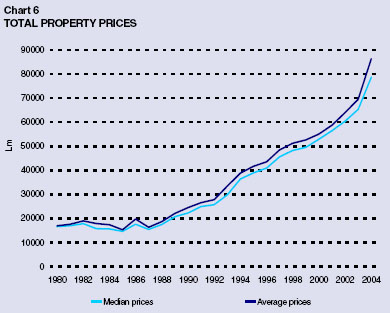
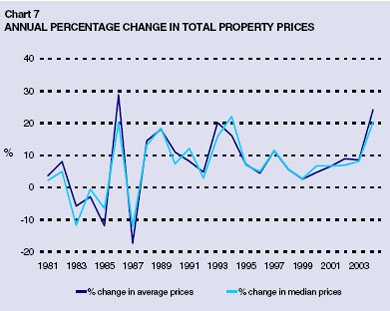
In addition, Table 7 shows the annual average
compound growth rates for each of the ten
categories of properties for both the 1980-2004 and
1987-2004 periods. Since property prices
remained relatively stable between 1980-1987, the
compound growth rates in the 1987-2004 period
are higher than in the 1980-2004 period for both
the average and median prices. Moreover, for
almost all categories of properties the growth rate
in median prices is smaller than the growth rate in
average prices.
For the 1980-2004 sample period, average prices
rose by 7% per year, while median prices rose by
6.7% per year. The highest annual rate of change
in average prices was for the luxury category at
8.6% per annum, while for median prices the
highest yearly growth rate was 8.2% for terraced
houses.
For the 1987-2004 sample period, average prices
and median prices rose by 10.3% per year and 10%
per year, respectively. The fastest annual growth
rate in average prices was 12.2% registered in the
maisonettes in shell form category, while the largest annual growth rate in median prices was
11.6% registered in the houses of character
category.
Meanwhile, the average yearly growth in the CPI
for the 1980-2004 period was 2.5%, while for the
1987-2004 period it also stood at 2.5%. This
implies that homeowners enjoyed a 4.6% real
return per year on average prices on overall
property types (4.2% real return on total median
prices) for the 1980-2004 period. In the latter
period (1987-2004) home owners enjoyed a 7.8%
real return per year on average prices on overall
property types and a 7.5% real return on total
median prices.
One effect of house price increases is
an expansion in consumption through a perceived
rise in consumer wealth. This increase
in consumption can take place through
two channels: directly through increased
consumption out of current income due to a lesser
need to save, and indirectly through borrowing for
consumption purposes as the rise in property
prices can provide additional equity release which is collateralised by property. Ludwig and Sløk
(2002) analyse the different impacts of stock and
house prices on consumption in 16 OECD
countries. They found that the long-run impact
on consumption of an increase in stock and
house prices is in general higher in countries with
a market-based (as opposed to bank-based)
financial system. In addition, the sensitivity of
consumption to changes in stock wealth is
approximately twice as large as the sensitivity to
changes in housing wealth.
The potential wealth effect is shown in Table 8.
The monetary value of the housing stock over
the years was calculated each year by
multiplying the number of dwellings in each
housing category in the 1995 Census by the final
average price in each category derived from the
Central Bank of Malta house price index. The
loans taken up by the personal sector towards the
purchase of dwellings were then deducted to
arrive at the net monetary value of the housing
stock. The net monetary value of 1995 housing
stock was Lm21.4 billion in 1995. By 2004, this
value at market prices more than doubled to Lm44.5 billion. Table 8 also shows the ratio over
the years of the value of the housing stock to
nominal GDP. One notes that although between
1995 and 2002 the ratio of the net monetary value
of the housing stock to nominal GDP was
relatively stable at an average of 17.56 times, in
2003 the ratio rose to 20.68 and in 2004 to 24.01
times.
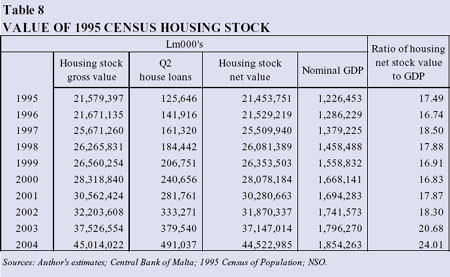
A BIS study (Sutton, 2002) on house prices in six
advanced economies found a positive relationship
between changes in equity values and house
prices over the medium to longer term.
Nevertheless, when comparing the return on
housing with the return on stock exchanges, one
has to note that households can borrow funds
from credit institutions to finance the purchase of
property but are unable to borrow the equivalent funds to purchase equities to the same extent.
Hence, households face a credit constraint to
invest in stock indices. One should also note that
for individual households, the interest payments
on mortgages should first be deducted before any
comparison of the rate of return on housing can
be made.
Chart 8 compares developments in house prices
and equity prices in Malta since the end of the
second quarter of 1995. Over this period, whereas
average house prices rose by 8.42% and median
house prices increased by 8.11% at an annual
compound rate, the MSEI went up by 10.83% on
the same basis. An explanation for the higher rate
of growth on the MSE could possibly be that the
MSE was still in its infancy and was characterised
by shallow trading where a few transactions could have had significant effects on market
movements.
However, the cumulative annual return on house
prices surpassed the return on other domestic
financial assets. Between 1995 and 2004, the
compound annual growth rate for time deposits
was 4.7%, for one-year Treasury bills it was 4.6%,
while that on ten-year government bonds was
5.88%. One should note that these assets are
more liquid and less risky and should therefore
offer lower returns than property.
Conclusion
This paper analysed the various factors that
influenced house prices in Malta between 1980
and 2004, when they increased by 7% on average
annually. It was found that the estimated increase
in the annual number of households is less than
the increase in the annual number of newly-built
properties. This suggests that there has been a
progressive increase in the excess supply of
properties in Malta. In spite of this excess, house
prices rose each year. The paper also analysed
the relationship between bank credit and the
demand for housing. It was noticed that banks
eased their lending practices in recent years and
consequently were able to provide larger mortgages for an extended number of years, thus
accommodating demand. Finally, it was noted that
over the last ten years, the return on property in
Malta was lower than that on the MSE but
surpassed that on other financial assets.
House prices in Malta appear to be increasing due
to the relative scarcity of land for development
purposes. As long as land remains scarce, its
relative price is expected to keep on rising with
demand. Prices in the housing market also depend
on the purchasing capacity of first-time buyers.
This factor drives the lower end of the housing
market, with prices of more expensive properties
also increasing as a result. This paper has shown
that the ratio between flat and maisonette prices
and first-time buyers’ income has increased. As
long as supply costs due to increased land and
construction prices keep on rising, and buyers still
have the capacity to purchase property due to the
availability of increased mortgages, house prices
are likely to continue to rise. The rising trend,
however, might end should current policies
governing the allocation of land for building be
eased or if the terms and conditions of mortgages
for house purchases are tightened.
A number of issues merit further study and
econometric work is underway to derive the
estimated empirical relationships between house
prices, bank credit and average disposable
income.
|

